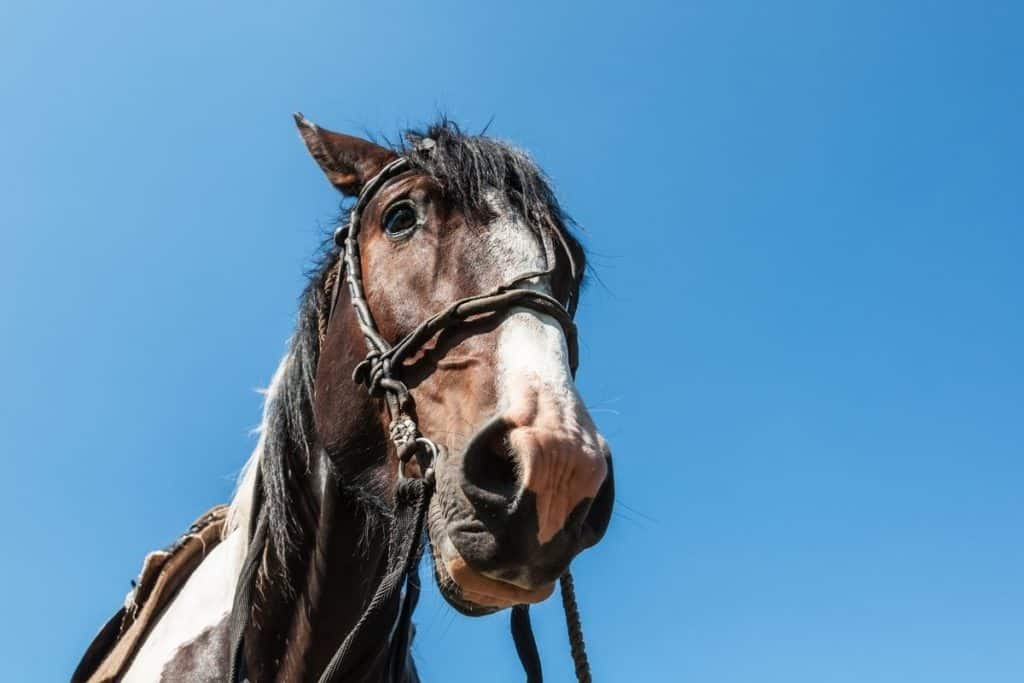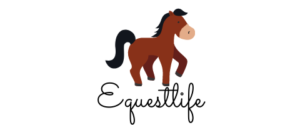If a horse is behaving or performing exceptionally well while on a ride, it may be tempting to offer it a treat. However, riders may wonder whether it’s safe to allow a horse to eat while it still has its bridle on.
A horse can eat with a bridle, but it is not recommended. Often, horses interpret the harness as a sign it is time to work. Allowing the horse to eat with it on can lead to training and behavioral issues, harm the animal, and make the bridle challenging to clean for the owner later.
Although it’s natural to assume a bitless bridle can be a solution to some of the above issues, this is not the case; there are some drawbacks associated with these types of harnesses as well.
Below, we’ll discuss the reasons why riders shouldn’t feed a horse with their bridles and tips to prevent them from trying to eat on their own while wearing one.
Can You Feed a Horse If the Bridle Is Still On?
There are many different types of bridles, but their general purpose remains the same: It allows you to engage the horse during training and work exercises.
The bridle contains components that can restrict your horse’s ability to chew and eat in a way that it would normally, although it still certainly can eat if it wishes. However, allowing your horse to do so is not recommended.
Why You Shouldn’t Feed a Horse with a Bridle
There are a few reasons why feeding is discouraged while a horse is wearing a bridle:
Bridle Components Make It Difficult to Eat
First, a bridle has a piece called a “bit,” consisting of a solid bar that runs across the horse’s tongue. This feature helps the rider apply pressure and reinforce commands. However, this component alone can make it difficult for the horse to chew.
There is also a piece called the “throat latch” that runs underneath the horse’s throat. Along with the bit, this component may restrict the horse’s ability to chew and swallow (although to a minor degree). A properly-fitted harness should not be overly restrictive to movement but should not allow a horse to put its tongue over the bit.
It May Harm the Horse
Some studies suggest that horses can be hurt if their teeth frequently chomp down on the bit of a bridle; some veterinarians have observed bone spurs and dental issues. Usually, this issue is more related to horse or handler riding behavior, but you still don’t want to encourage your horse to eat while wearing the bit to avoid the problem further.
Bitless bridles are not necessarily the answer to this problem, either. This is because bitless bridles often contain a thick nosepiece to compensate for the lack of a bit; this can still cause harm to the horse if overused. For this reason, they’re usually reserved for young horses.
It’s Harder to Distinguish Work and Feeding Time
Bridles are a piece of equipment that should be exclusively associated with working time. Once the bridle and bit come off, then your horse should be able to take this as a sign that work and training activities have come to an end, at least for the time being.
It cannot be understated just how vital repetition and consistency are in equine training. Any time that you try breaking a negative pattern, you will only be met with crankiness. Letting your horse pick up food whenever it wants has the negative effect of leading your horse to believe that it is okay to always beg for a goodie, even though it’s time to work.
It Affects Their Herd Mentality
Horses use feeding opportunities to signal their standing within a group. Access to both food and water is used to determine who the top members of the herd are.
Any horse that is eating or drinking will be perceived as the dominant member of the herd when the others don’t currently have access to the food or water. If these are not the type of signals you want to send during training, you want to avoid allowing the horse to graze with the bridle.
It Requires Extra Cleaning
As mentioned, the bit of the bridle is the piece that fits across the horse’s tongue. While this will not completely impede a horse’s ability to eat and breathe properly, you are still advised to avoid feeding while it wears this piece.
This is because the bit will become dirty from the horse eating while wearing it. When you remove the bridle and bit from your horse, you will notice a green gooey mess across the bit, which can be challenging to remove.
The Horse May Become Unsafe to Ride
If a horse is not fully broken in or trained, it will be a hazard to kids and inexperienced riders. Letting a horse eat with a bridle on will lead them to believe that they can stop and chow down whenever they please.
Inexperienced riders, in particular, need to be given a horse that you are confident won’t give them too much trouble. Poorly-trained horses become a danger to themselves and others when they become opportunistic feeders during work time. They may become so sidetracked by food items that they may inadvertently step into a hole or walk their rider into a fence.
How to Stop a Horse from Eating with a Bridle On

It is not uncommon for a horse to become a notorious “grass grabber.” This type of behavior should be nipped in the bud as soon as it arises. Horses that feed on grass while on the trail won’t see you as a figure of authority, and as previously mentioned, can also be a danger to riders because they will become distracted easily.
With that said, proper training is key to protecting yourself as the rider and your horse. Here are some things you can do to discourage them from eating while the bridle is on:
- Make them hustle: Let your horse know that you expect them to move forward at a steady pace.
- Squeeze the horse with your calves: If the previous tip doesn’t work, you can make warning noises by clicking your tongue. If all else fails, pop your horse with the ends of the reins. Continue to do this every time they try to deviate from the path to eat.
Note: When giving negative reinforcement, be as gentle as possible while still being firm. Your horse should know it is doing something wrong, but there is no need to be excessively harsh.
(Source: Horse & Rider, Ryttarens.se)
Can I Give My Horse a Treat with a Bridle On?
Positive reinforcements are indeed another aspect of horse training and are often offered in the form of food. In these instances, it is safe to provide your horse the occasional treat while its bridle is on, but there are some things to keep in mind when doing so.
If you are going to give your horse a treat while still wearing a bridle, you are encouraged to provide them with a treat that will dissolve in their mouth, like a sugar cube. Treats like sugar cubes can be a good reward for your horse during training activities, particularly for short-term task training.
However, although dissolvable treats are safe, remember that food should not be used as the sole reinforcement tool; this will prevent your horse from becoming distracted by food while working later.
In Summary
Although your horse will technically still be able to graze and eat while wearing a bridle, you are generally discouraged from allowing this to happen.
Not only will it mess with your training and lead to behavioral issues, but it can also harm the horse or make it dangerous to ride. Additionally, letting your horse eat with a bit on can create a bigger mess for you to clean up later.
The only instance in which a horse should be able to eat is for positive reinforcement during training. Still, even then, it should only be offered dissolvable treats every so often rather than regularly, so you don’t accidentally reinforce negative behavior.
